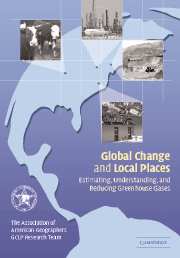Book contents
- Frontmatter
- Contents
- List of contributors
- Foreword
- Preface
- Acknowledgments
- Part One Global change and local places
- Part Two Learning from localities
- Part Three Beyond Kyoto I: greenhouse gas reduction in local places
- 7 Changing places and changing emissions: comparing local, state, and United States emissions
- 8 Explaining greenhouse gas emissions from localities
- 9 Attitudes toward reducing greenhouse gas emissions from local places
- 10 Reducing greenhouse gas emissions: learning from local analogs
- Part Four Beyond Kyoto II: greenhouse gas reduction potentials and strategies
- Index
- References
10 - Reducing greenhouse gas emissions: learning from local analogs
Published online by Cambridge University Press: 31 July 2009
- Frontmatter
- Contents
- List of contributors
- Foreword
- Preface
- Acknowledgments
- Part One Global change and local places
- Part Two Learning from localities
- Part Three Beyond Kyoto I: greenhouse gas reduction in local places
- 7 Changing places and changing emissions: comparing local, state, and United States emissions
- 8 Explaining greenhouse gas emissions from localities
- 9 Attitudes toward reducing greenhouse gas emissions from local places
- 10 Reducing greenhouse gas emissions: learning from local analogs
- Part Four Beyond Kyoto II: greenhouse gas reduction potentials and strategies
- Index
- References
Summary
Global change is rooted in localities. The impacts of global warming, as well as adaptations to warming and attempts to ameliorate it, will occur in communities at local and regional scales. In some respects global climate change is analogous to other societal dilemmas. Local communities contribute to large, intractable problems; local initiatives may arise in the absence of larger efforts to address the problems; and localities grapple with policies and regulations imposed upon them from afar. Within each Global Change and Local Places study area, there are human–environment analogs that yield insights into how greenhouse gas mitigation could proceed at locality scale.
Earlier chapters have documented the import of understanding the driving forces that generate regional greenhouse gas emissions, tracked changes in emissions through time, and assessed greenhouse gas abatement potentials in the Global Change and Local Places study areas. Examining the structures and dynamics of societal attempts to mitigate threats analogous to global warming offers fresh insights for science and policy formulation. Whereas prior work has focused on using analogs to anticipate impacts and adaptation, this chapter emphasizes analogy to understand mitigation processes. For purposes of this analysis, adaptation denotes the array of societal coping responses to an environmental threat such as climate change. Mitigation means efforts to abate the threat itself, such as limiting the release of greenhouse gases or acting to absorb them.
- Type
- Chapter
- Information
- Global Change and Local PlacesEstimating, Understanding, and Reducing Greenhouse Gases, pp. 192 - 214Publisher: Cambridge University PressPrint publication year: 2003
References
- 2
- Cited by



